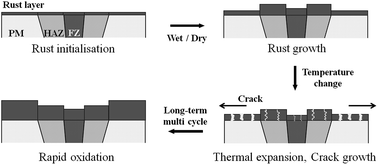Corrosion behaviour of welded low-carbon steel in the Arctic marine environment†
Abstract
Arctic offshore sites have high potential for the exploration of energy resources; thus, data concerning the behaviour of structural materials in the Arctic environment are required. Here, we report the corrosive characteristics of welded low-carbon steels under simulated Arctic low-temperature conditions. The corrosion tendencies in the submerged and splash zones of offshore structures were investigated by immersion tests, salt spray tests (SST), and cyclic corrosion tests (CCT). The effects of decreasing seawater temperature on the corrosion were identified, and the differences in corrosion between the base metal (BM) and weld metal (WM) were analysed. In particular, the BM showed higher corrosion than the WM, indicating that the parent metal (PM) is corroded more than the fusion zone (FZ) in weld joints under severe corrosion conditions. Thus, we have identified the importance and influence of the thermal expansion of materials on corrosion under Arctic conditions.



 Please wait while we load your content...
Please wait while we load your content...